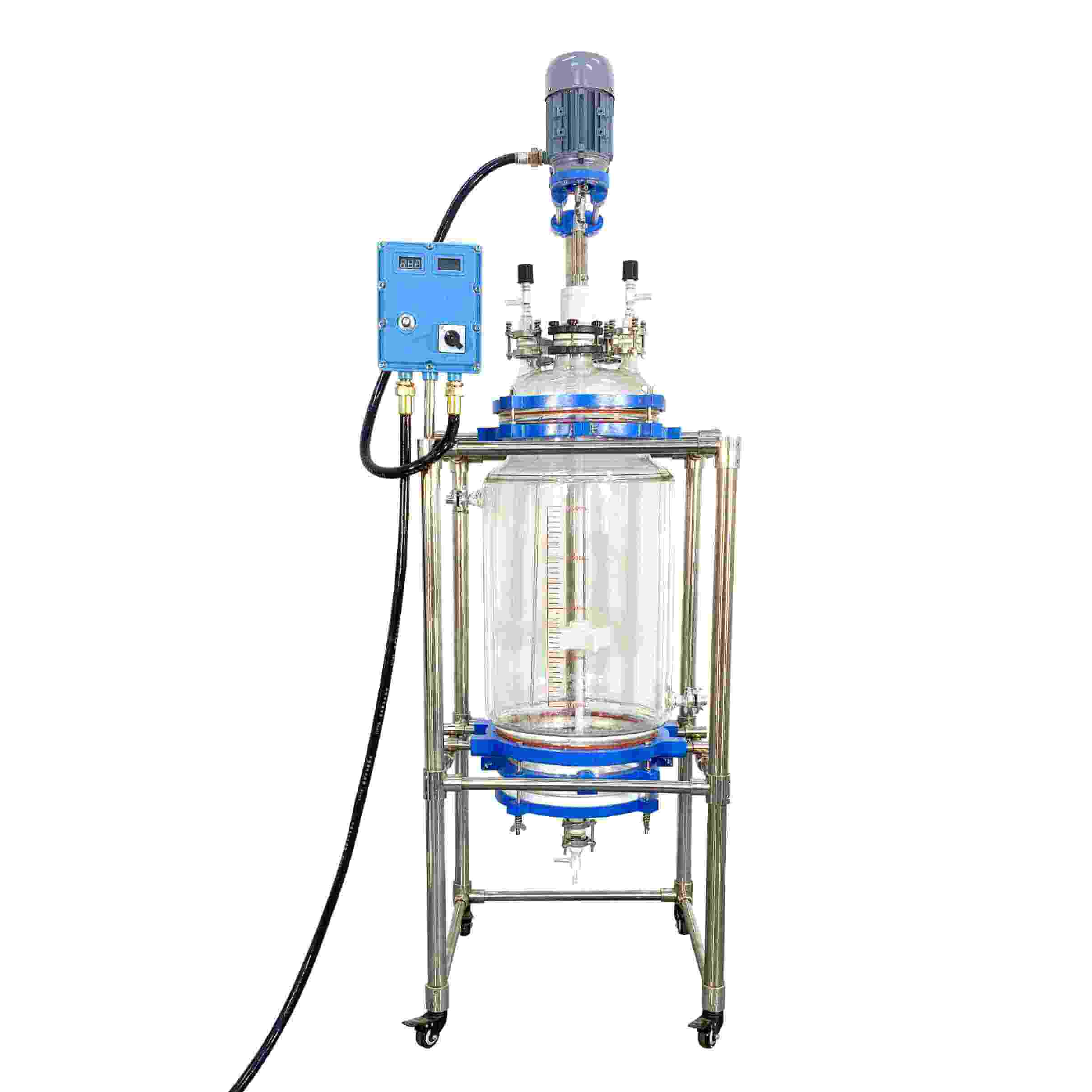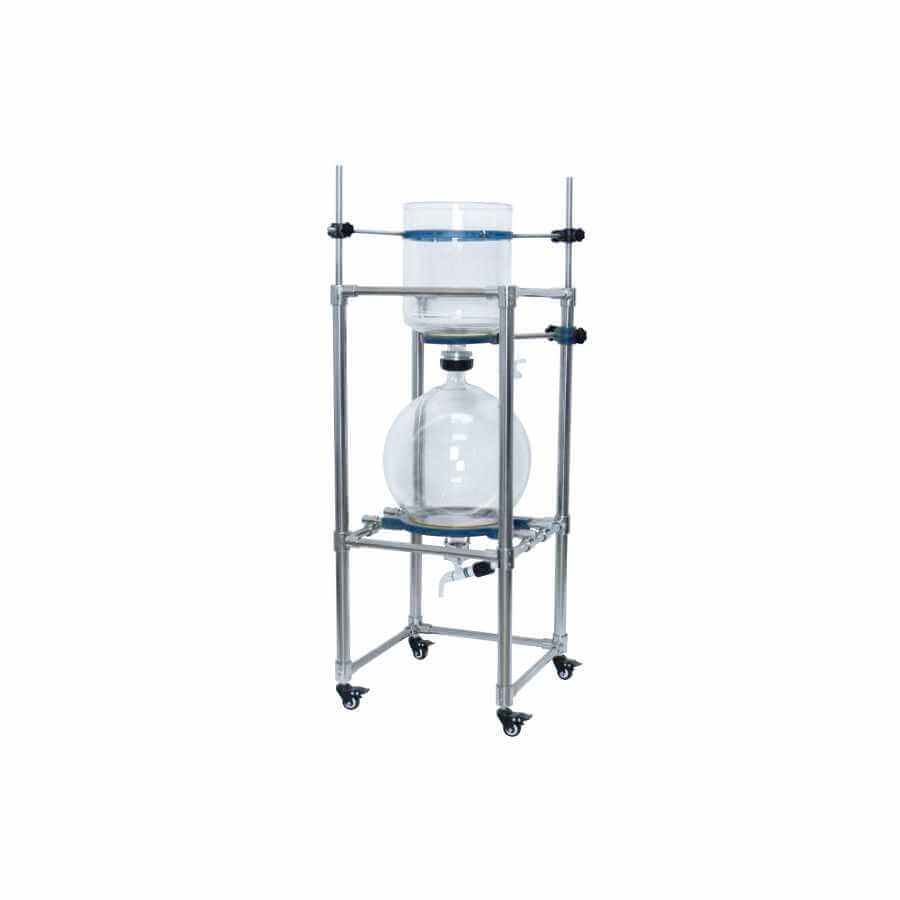

Glass Reactor
Glass reactors: used in chemical reactions, drug research and development, fine chemicals, food manufacturing, and other fields.
Material
glass
Capacity (L)
10-10000+
Mixing system
anchor, paddle, frame and others
Heating system
electric heating, oil heating and others
RUNGYU glass reactors are commonly used biochemical instruments and are widely used in modern fine chemicals, biopharmaceuticals, scientific research and experiments, and other industries. They can be used for concentration, distillation, reflux, separation, and purification reactions under the conditions of constant speed, constant force, and constant temperature. It is an ideal equipment for teaching, experiment, pilot test, and production.
Request a quoteThe glass reactor is stirred and reacted under normal pressure or negative pressure in a closed container under the set constant temperature condition and can control the evaporation and reflux of the reaction solution. Generally, there are single-layer glass reactors and double-layer glass reactors. In addition to the above two types of reactors, there are also three-layer glass reactors, which not only have the function of double-layer reactors but also have the function of vacuum insulation.

Technical guidance for cooling and heating of double-layer glass reactor
1. The liquid cycle of the entire glass reactor system is closed, and the system has an expansion vessel. The expansion vessel and the liquid cycle are adiabatic. It does not participate in the liquid cycle but is only a mechanical connection. The temperature of the medium in the expansion vessel must be low. At 60 degrees, regardless of whether the temperature of the liquid circulation is high or low.
2. The entire liquid cycle is a closed system, there is no water vapor absorption at low temperatures, and no oil mist is generated at high temperatures, the heat transfer oil can work at a wide range of temperatures; the same machine, the same heat transfer medium can achieve -100 degrees to 200 degrees temperature control. The cooling capacity ranges from 1KW to 80KW.
3. Mechanical and electronic valves are not used in the whole circulation system.
The main disadvantages of the traditional collusion slotted temperature control device are
I. The volume of the oil bath is large
The oil bath has two main functions
A. Hold the heat transfer medium
B. The heat transfer medium has the physical properties of thermal expansion and contraction, and the tank body is equivalent to an expansion container. The slotted system controls the external circulation, such as jacket reactor, the larger the volume of the reactor, the larger the volume of the jacket, the more heat transfer medium in the whole system, the greater the concentration change during heating and cooling, oil bath, water bath The larger the volume requirement. The heat load during the temperature change of the whole system is the total amount of heat transfer oil in the whole system (mainly) the reactants in the chemical reactor. The larger the volume of the water bath and the oil bath, the smaller the effective power used in the kettle and the temperature of the reactants in the kettle. And the speed response and cooling rate are slower. The temperature control of the reactor is based on the temperature change of the heat-conducting oil in the jacket of the reactor to control the temperature in the kettle. The more heat-conducting medium in the system, the less effective power is used in the kettle and the slower the temperature control speed.
II. Absorption of water vapor When reacting at low temperature, the surface temperature of the slotted oil bath is very low, and it is easy to absorb water vapor in the air and freeze on the surface of the compressor’s evaporator. Ice is a good insulator, and the compressor’s evaporator is insulated and cannot conduct heat, so the compressor cannot cool the heat transfer medium and thus cannot reduce the temperature in the kettle.
III. When the oil mist reacts at high temperature, the heat transfer oil will volatilize into the air in the laboratory and condense on the surface of the furniture, blocking the filter of the fume hood. Due to the different flash points of the heat transfer oil, some of them can cause combustion and explosion. It can only be used at 5 degrees below the flash point, so the temperature range of heat transfer oil is relatively limited, so one medium is needed at high temperature, and another medium needs to be replaced at low temperature. In addition, heat transfer oil is easy to brown and oxidize at high temperatures. Therefore, the heat transfer oil needs to be replaced regularly, and the use cost is relatively high.
IV. Heating and cooling need to be switched manually, which is prone to misoperation and accidents.
The product of the rapid heating and cooling system realizes the precise control of the temperature of the reaction, and the characteristics are as follows
1. Equipped with a heating and cooling integrated container, the heat exchange area is large, the heating and cooling rates are fast, and the demand for heat transfer oil is relatively small.
2. It can realize continuous temperature rise and fall, and the compressor technology is used to operate under high temperature and high pressure, and the compressor can be directly turned on for refrigeration from 200 degrees to improve the energy efficiency ratio.
3. With the function of correcting the external circulation and internal circulation temperature probe PT100.
4. Adopt CFC-free and HCFE refrigerant.
5. Precisely control the speed of chemical reactors.
6. The whole cycle is airtight, there is no oil mist volatilization at high temperatures, and the heat transfer oil will not be oxidized and browned; it will not absorb water vapor in the air at low temperatures; prolonging the life of heat transfer oil.
7. With self-diagnosis function, freezer overload protection, high-pressure pressure switch, overload relay, thermal protection device, and other safety protection functions, fully guarantee the safety of use;
8. Temperature adaptive control: In the process of controlling the process (such as the chemical reactor process), the adaptive control system continuously adjusts the PID parameters to give the process the best control temperature and response time. This process is achieved through effective multi-directional It is achieved by measuring temperature, temperature change, and rate of temperature change.




